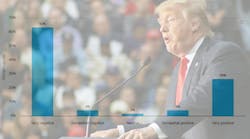Regulatory Updates
Several 2017 storm water issues are carrying over to 2018. They include implementing the U.S. EPA’s municipal separate storm sewer system (MS4) General Permit Remand Rule, navigating the role of storm water in the jurisdictional quagmire of redefining Waters of the U.S. (WOTUS), understanding EPA’s draft Guide for Voluntary Long-Term Planning, and federal litigation on the “maximum extent practicable” (MEP) standard.
The MS4 Phase II Remand Rule
A year into EPA’s MS4 General Permit Remand Rule, delegated states with permitting authority are beginning to replace administratively continued permits with new MS4 permits in order to meet the Remand Rule’s procedural and public participation requirements. The Remand Rule allows NPDES permitting authorities to choose between two types of general permits: one that is comprehensive at the outset and one that is less detailed but requires submission of comprehensive Notices of Intent.
Oregon and Maine are among the first states since the Remand Rule went into effect to issue draft MS4 Phase II general permits. Oregon regulators selected the comprehensive general permit approach, whereas Maine regulators haves opted for the two-step general permit with additional terms and conditions for small MS4 permittees to be established at a later date. As states work to implement the Remand Rule, it is likely that MS4 permit implementation issues will surface.
Redefining WOTUS
Storm water is entangled in the regulatory rewriting of the WOTUS definition. EPA is quickly progressing with its two-step rulemaking to withdraw the 2015 Clean Water Rule, reinstate the regulatory framework in place previously, and develop a new WOTUS definition. The 2015 Clean Water Rule excludes storm water control features that are constructed to convey, treat or store storm water from the WOTUS definition. Although this exclusion was added to the 2015 Clean Water Rule, it reflects an established practice to exempt green infrastructure and low impact development projects from certain permitting and maintenance requirements. As the WOTUS definition takes shape, it is imperative that any new definition maintain and clarify this storm water control exclusion.
Long-Term Planning Guide
Last year, EPA published its draft Community Solutions for Stormwater Management: A Guide for Voluntary Long-Term Planning to help states and local communities develop long-term storm water plans. As part of the strategy, EPA also selected five communities to develop long-term storm water plans. Any lessons learned will be used as national models. This effort currently is underway and updates are expected in 2018.
Complementing the EPA’s Long-Term Stormwater Planning Guide, the U.S. Government Accountability Office (GAO) released a study last year examining the use of green infrastructure (GI) to control urban storm water, particularly in the context of combined sewer overflows. The report, which was requested by Congress, describes how municipalities are incorporating and funding GI efforts. Of the 31 municipalities surveyed in the study, 26 communities reported that using GI was more challenging than using gray infrastructure, especially when developing operation and maintenance cost estimates. Nevertheless, 25 communities also reported continued use of GI even if it was more challenging.
The report also recommends that the EPA document agreements (e.g., memorandum of understanding) when working with municipal departments and other stakeholders. By documenting these collaborative agreements, the GAO report concludes that EPA could have better assurance that groups will successfully develop and implement long-term storm water plans. EPA indicated that it generally agreed with the GAO recommendation and plans to begin developing collaborative agreements with municipalities over the next year.
MEP Litigation
Over the last two years, EPA Region 1 has issued nearly identical Small MS4 General Permits first for Massachusetts and New Hampshire—both of which significantly expand upon traditional MS4 permit requirements. Massachusetts and New Hampshire are non-delegated states and do not have authority to issue NPDES permits. Therefore, the permit language could potentially indicate the EPA’s preferred permit terms.
The permits pose a variety of challenges. For example, permittees are required to reduce the discharge of pollutants to the Clean Water Act's traditional MEP standard, and the permits have provisions that require further water quality standards (WQS) protection. New language in both permits requires that MS4s “do not cause or contribute to an exceedance of WQS, in addition to requirements to reduce the discharge to the maximum extent practicable.” These permits require strict compliance with WQS and impose specific obligations on MS4s to meet these requirements. The permit also requires the MS4s to impose numeric flow retention standards for new development and redevelopment projects within their communities. Regulating flow may be required by state or local law, but it is not within the EPA’s authority to regulate under the Clean Water Act.
A variety of groups have challenged the New Hampshire and Massachusetts permits based on their inclusion of water quality-based effluent limitations. The cases have been consolidated in the U.S. Court of Appeals in Washington, D.C.. While these appeals are pending, EPA has postponed the Massachusetts permit effective date for one year until July 1, 2018 pending judicial review and to explore a possible settlement.
The EPA’s recent shift to include WQS not only arguably exceeds the agency’s authority under the statute, but also requires municipalities to allocate additional resources and pollution control technologies to meet these more stringent standards. EPA’s WQS are problematic for many small municipalities because of the nature of MS4 discharges and the improbability of controlling what pollutants are discharged and at what quantities.
States around the country could look to the permit language and incorporate increased monitoring and inspection requirements and include more stringent WQS-based limits. If so, these heightened storm water permitting requirements could have significant compliance costs for municipal clean water agencies and MS4s already facing increasing operational, maintenance and affordability challenges.


